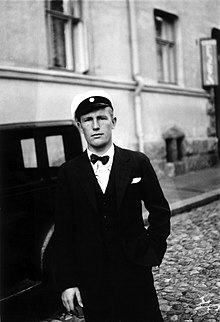Gunnar Svaetichin (scientist)
| Gunnar Svaetichin | |
|---|---|

Gunnar Svaetichin in his student cap
|
|
| Known for | Discovery of S-potentials |
Gunnar Svaetichin (1915-1981) was a Swedish-Finnish-Venezuelan physiologist who, in 1956, showed by examining the external layers of fish retinas that electroretinograms display particular sensitivity to three different groups of wavelengths in the areas of blue, green and red. This provided the first biological demonstration in support of the Young-Helmholtz trichromatic theory. He also gave name to the S-potential, which was the first experimental evidence that opponency existed in the visual system.
He was born in 1915 in Karis, Finland, the son of the engineering surveyor Volmar Svaetichin and his wife Ellen (born Nordstrom).
After attending schools in Karis and Helsinki, he went on to graduate from medical school at the University of Helsinki, where he also worked as a researcher. During his medical studies in Helsinki, Svaetichin got to know the young Ragnar Granit, who had returned after some years in the US and Oxford and become a professor of physiology. His first work as a doctor was when the Finnish winter war broke out and Svaetichin was drafted and sent to a first aid station located just behind the front lines.
In cooperation with Ragnar Granit, Svaetichin developed a new methodology for electrophysiological study of vision. They made fine needle electrodes that could register signals from the major nerve cells in the retina, which sends its threads in the optic nerve to the brain. It was with this technique that Ragnar Granit could perform his famous studies of color vision.
...
Wikipedia
